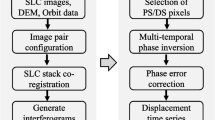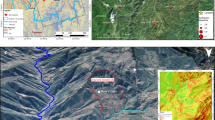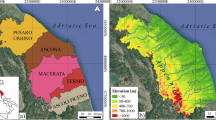Abstract
The paper presents the results of the processing of satellite radar images acquired by the TerraSAR-X satellite using the persistent scatterer method for analyzing the subsidence of the earth’s surface over potash mines in the city of Berezniki, Perm Krai. A sequence of processing procedures in the GAMMA Software package (Gamma Remote Sensing AG, Switzerland) is presented, which showed good results in the conditions of this territory. A comparison is made with the results obtained earlier by summation of interferograms. In contrast to the methods of persistent scatterers, the summation is performed without analyzing displacements in time. The noisy time series obtained by the summation are not rejected, so the displacement maps cover the study area more evenly. In the persistent scatterer method, the time series is analyzed using a variety of criteria, so the subsidence rates are estimated more reliably. In the areas where the results were obtained by summation and the persistent scatterer method, the subsidence rates are in good agreement. The persistent scatterer method has made it possible to estimate displacements in certain areas separated by vast incoherent woodlands, on which interferograms lose their coherence. At the same time, a new subsidence area was identified with an average rate of subvertical displacements up to 75 mm/year and, in some areas, up to 100 mm/year, which, according to data for 2020 and 2018, was not detected. The subsidence here should be clarified based on the images for subsequent years or using surface thechniques. The time series also show the deceleration of subsidence in spring on persistent scatterers located on buildings and infrastructure. We associate the total spring deceleration of subsidence by 3–5 cm not with underground but with seasonal factors, specifically with the heating of buildings in the spring. Other reasons are also possible, but the main one is that, in areas with a moderate subsidence rate, this effect can lead to some underestimation of the average subsidence rate. A detailed study of the time series for subsidence makes it possible to identify areas requiring special attention. Most of the subsidence occurs more or less evenly; in a significant part of the territory, the subsidence rate in 2021 has decreased. This indicates the effectiveness of the measures taken to protect the ground infrastructure. Within the city area, the acceleration of subsidence was found only at the beginning of Lenin Avenue. SAR interferometry is an effective tool for studying subsidence processes in the city of Berezniki. This method significantly complements geodetic works, since it provides data on vast areas that cannot be covered by detailed ground measurements. In addition, part of the closed territories becomes dangerous for ground works, so there is no alternative to satellite technologies.









Similar content being viewed by others
REFERENCES
Babayants, I.P., Baryakh, A.A., Volkova, M.S., Mikhailov, V.O., Timoshkina, E.P., and Khairetdinov, S.A., Monitoring of subsidence in Berezniki (Perm region) by SAR interferometry: I. Differential interferometry, Geofiz. Issled., 2021, vol. 22, no. 4, pp. 73–89. https://doi.org/10.21455/gr2021.4-5
Baryakh, A.A., Krasnoshtein, A.E., and Sanfirov, I.A., Mining accidents: Flooding of the First Bereznikovsky potash mine, Vestn. Permsk. Nauchn. Tsentra, 2009, no. 2, pp. 40–49.
Baryakh, A.A., Sanfirov, I.A., and Dyagilev, R.N., Monitoring the consequences of flooding a potash mine, Gorn. Zh., 2013, no. 6, pp. 34–39.
Berardino, P., Fornaro, G., Lanari, R., and Sansosti, E., A new algorithm for surface deformation monitoring based on small baseline differential SAR interferograms, IEEE Trans. Geosci. Remote Sensing, 2002, vol. 40, no. 11, pp. 2375–2383. https://doi.org/10.1109/TGRS.2002.803792
Bush, V., Hebel, H.P., Schaffer, M., Valter, D.Yu., and Baryakh, A.A., Control of underworked areas subsidence using the radar interferometry methods, Marksheideriya Nedropol’zovanie, 2009, no. 2, pp. 38–43.
Gnevanov, I.V. and Shamin, P.V., Assessment of deformations of the earth’s surface of mining area of the “Uralkali” in the Berezniki city by methods of radar interferometry, Geomatika, 2012, no. 1, pp. 56–60.
Hooper, A., Segall, P., and Zebker, H., Persistent scatterer interferometric synthetic aperture radar for crustal deformation analysis, with application to Volcán Alcedo, Galápagos, J. Geophys. Res.: Solid Earth, 2007, vol. 112, p. B07407. https://doi.org/10.1029/2006JB004763
Kiseleva, E.A., Mikhailov, V.O., Smolyaninova, E.I., and Dmitriev, P.N., On monitoring surface displacements of natural terrains using SAR interferometry, Sovrem. Probl. Distantsionnogo Zondirovaniya Zemli Kosmosa, 2017, vol. 14, no. 5, pp. 122–132. https://doi.org/10.21046/2070-7401-2017-14-5-122-132
Mikhailov, V.O., Kiseleva, E.A., Smolyaninova, E.I., Dmitriev, P.N., Golubeva, Yu.A., Isaev, Yu.S., Dorokhin, K.A., Timoshkina, E.P., Khairetdinov, S.A., and Golubev, V.I., Landslide monitoring at the North Caucasus rail road using SAR data of different wavelength and corner reflector, Geofiz. Issled., 2013, vol. 14, no. 4, pp. 5–22.
Mikhailov, V.O., Kiseleva, E.A., Baryakh, A.A., Isaev, Yu.S., and Smolyaninova, E.A., On the possibilities of monitoring the dynamics of the development of subsidence of the earth’s surface on the territory of Berezniki using images from the Sentinel satellite, XI Vserossiiskaya shkola-seminar s mezhdunarodnym uchastiem Fizicheskie osnovy prognozirovaniya razrusheniya gornykh porod. Tezisy dokladov (11th All-Russian School-Seminar with Int. Participation Physical Foundations of Forecasting Rock Fracture), Perm: Gornyi Inst. Ural. Otd. Ross. Akad. Nauk, 2019, pp. 35–36.
Samsonov, S. and Baryakh, A., Estimation of deformation intensity above a flooded potash mine near Berezniki (Perm krai, Russia) with SAR interferometry, Remote Sensing, 2020, vol. 12, no. 19, p. 3215. https://doi.org/10.3390/rs12193215
ACKNOWLEDGMENTS
We are grateful to the German space agency Airbus Defense and Space GmbH and the European Space Agency ESA for providing the images. We are also grateful to professor T.N. Chimitdorzhiev and an anonymous reviewer, whose comments and advice contributed to the improvement of the presentation of the material.
Funding
This work was supported by the Russian Science Foundation (grant no. 19-77-30008).
Author information
Authors and Affiliations
Corresponding author
Ethics declarations
The authors declare that they have no conflicts of interest.
Additional information
Translated by E. Chernokozhin
Rights and permissions
About this article
Cite this article
Babayants, I.P., Baryakh, A.A., Mikhailov, V.O. et al. Monitoring of Subsidence in Berezniki City (Perm Krai) by SAR Interferometry. Method of Persistent Scatterers. Izv., Phys. Solid Earth 59, 1066–1078 (2023). https://doi.org/10.1134/S1069351323060034
Received:
Revised:
Accepted:
Published:
Issue Date:
DOI: https://doi.org/10.1134/S1069351323060034




